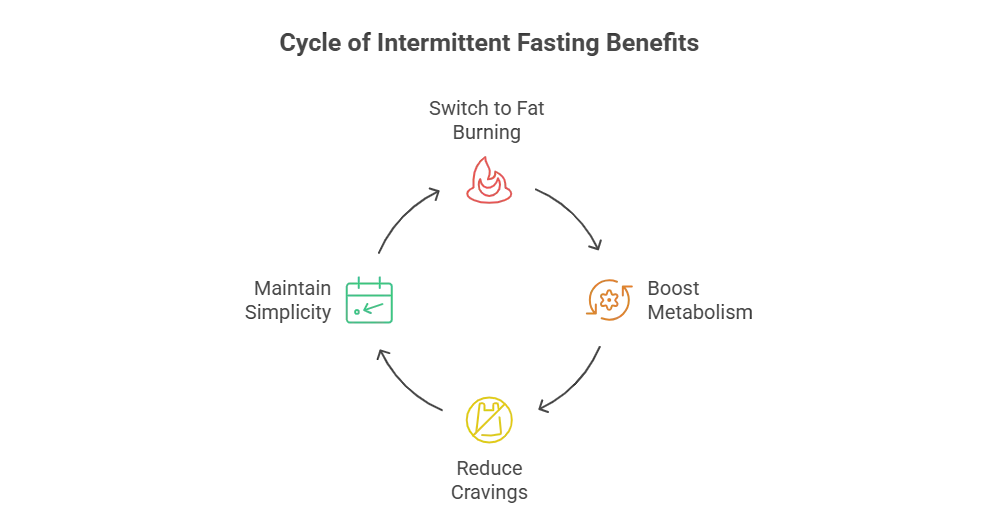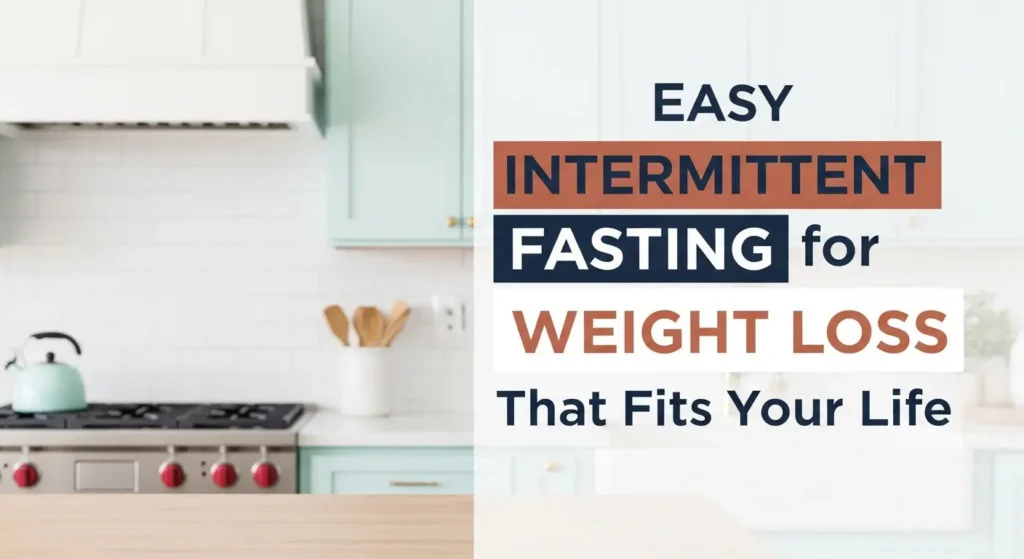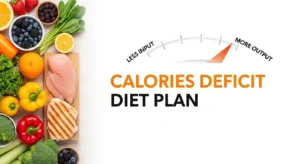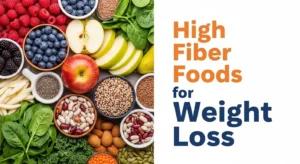Imagine a lifestyle where you eat delicious food, feel more energetic, and gently guide your body towards a healthier weight, all without feeling like you're constantly on a diet. Sounds pretty good, right? That's the promise of intermittent fasting for weight loss, a popular eating pattern that focuses on when you eat rather than what you eat.

Many people think of intermittent fasting for weight loss as a strict, difficult process, but it doesn't have to be! This article will show you how to make intermittent fasting easy and flexible, so it truly fits into your life, helping you reach your weight loss goals without feeling deprived or overwhelmed. We'll explore simple methods, practical tips, and how to enjoy your meals while still getting amazing results.
Key Takeaways
- intermittent fasting for weight loss (IF) is about when you eat, not just what you eat. It involves setting specific eating and fasting windows.
- IF can help with weight loss by encouraging your body to burn stored fat. It also improves how your body uses insulin.
- There are several easy IF methods to choose from, like 16/8 or 14/10, making it simple to find one that fits your daily routine.
- Flexibility is key! You can adjust your fasting schedule to match your social life, work, and energy levels.
- Focus on nutrient-rich foods during your eating window to support your body and make fasting easier.
What Exactly Is Intermittent Fasting For Weight Loss?
Intermittent fasting isn't a diet in the traditional sense. You don't count calories or restrict specific foods (though healthy eating is always recommended!). Instead, it's an eating pattern where you cycle between periods of eating and voluntary fasting. Think of it as giving your body a regular break from digestion.

For most of our history, humans didn’t have food available 24/7. Our bodies are designed to go for periods without eating. Intermittent fasting for weight loss taps into these natural processes. When you fast, your body uses up its stored sugar (glycogen). Once that’s gone, it starts burning stored fat for energy. This is where the magic happens for weight loss!
How Does Intermittent Fasting Help with Weight Loss?
When you eat, especially foods high in carbs, your body releases insulin. Insulin's job is to move sugar from your blood into your cells for energy. But high insulin levels can also tell your body to store fat. When you fast, your insulin levels drop. This sends a signal to your body: “Time to burn some fat!”
Here's a quick look at the benefits:
- Fat Burning: As mentioned, your body switches from burning sugar to burning fat.
- Metabolic Boost: Some studies suggest intermittent fasting for weight loss can improve your metabolism, meaning your body burns calories more efficiently.
- Reduced Cravings: Many people find that after adjusting, their cravings for unhealthy snacks decrease.
- Simplicity: No complex meal plans or calorie counting, just a clear eating schedule.

Popular and Easy Intermittent Fasting Methods
The beauty of intermittent fasting for weight loss is its flexibility. There isn't just one way to do it. You can choose a method that best suits your lifestyle. Here are some of the most popular and easy ones:
- The 16/8 Method (LeanGains Protocol):
- How it works: You fast for 16 hours and have an 8-hour eating window. For example, if you finish dinner at 8 PM, you wouldn't eat again until 12 PM (noon) the next day. This often means skipping breakfast.
- Why it's easy: A large part of your fasting window is spent sleeping! You just need to push your first meal back a bit.
- Example Schedule:
- Last meal: 7 PM
- Fast ends: 11 AM next day
- Eating window: 11 AM – 7 PM
- Many people find this the easiest to stick with long-term.
- The 14/10 Method:
- How it works: Similar to 16/8, but with a shorter fast (14 hours) and a longer eating window (10 hours).
- Why it's easy: Even more flexible than 16/8, great for beginners or those who find 16 hours too long initially.
- Example Schedule:
- Last meal: 8 PM
- Fast ends: 10 AM next day
- Eating window: 10 AM – 8 PM
- The 12/12 Method:
- How it works: You fast for 12 hours and eat within a 12-hour window.
- Why it's easy: This is often what people naturally do if they don't snack late at night or eat very early breakfast. It's a great starting point!
- Example Schedule:
- Last meal: 7 PM
- Fast ends: 7 AM next day
- Eating window: 7 AM – 7 PM
- Eat-Stop-Eat (24-Hour Fast):
- How it works: You fast for a full 24 hours, once or twice a week. For example, you might eat dinner on Monday, then not eat again until dinner on Tuesday.
- Why it's easy: You only do it occasionally, so most days are “normal.”
- Important: This method can be more challenging and is usually for those more experienced with IF. Start with shorter fasts first!
- 5:2 Diet:
- How it works: You eat normally for five days of the week and restrict your calorie intake to 500-600 calories on two non-consecutive days.
- Why it's easy: Most days you eat as usual, and the fasting days still allow a small amount of food.
- This method is less about a true “fast” and more about calorie restriction on specific days.
Which method is best for you? The one you can stick with! Start with a shorter fast like 12/12 or 14/10 and gradually increase if you feel comfortable. Listen to your body!
Making Intermittent Fasting Fit Your Life: Practical Tips
The key to success with intermittent fasting for weight loss is making it a sustainable part of your lifestyle, not a temporary diet. Here's how to make it easy and flexible:
1. Start Slow and Be Patient
Don't jump straight into a 16-hour fast if you've never tried intermittent fasting for weight loss before. Begin with a 12-hour fast, then move to 14, then 16. Give your body time to adjust. The first few days might feel a little different, but most people adapt quickly.
2. Hydrate, Hydrate, Hydrate!
During your fasting window, you can (and should!) drink:
- Water (plain, sparkling)
- Black coffee (no sugar, no cream)
- Plain tea (herbal, green, black – no sugar, no milk)
- Electrolyte water (sugar-free)
These drinks help keep you full, energized, and prevent headaches. Sometimes, what feels like hunger is actually just thirst!
3. Plan Your Eating Window Strategically
Think about your daily schedule:
- Are you a morning person or a night owl? If you love breakfast, maybe a 14/10 fast where you stop eating at 6 PM and start at 8 AM works better. If you prefer late dinners, skipping breakfast might be easier.
- Do you have social events? If you have a dinner party planned, you can shift your eating window for that day. intermittent fasting for weight loss is flexible! Don't let it stop you from enjoying life.
- Consider your workout schedule. Some people prefer to work out during their fast, while others need fuel beforehand. Experiment to see what works for you.
4. Focus on Nutrient-Rich Foods During Your Eating Window
Intermittent fasting isn't a license to eat junk food. For weight loss and overall health, what you eat during your eating window is still super important. Aim for:
- Whole, unprocessed foods: Vegetables, fruits, lean proteins, healthy fats, whole grains.
- Plenty of protein: Helps you feel full and preserves muscle mass. Think chicken, fish, eggs, beans, lentils.
- Healthy fats: Avocados, nuts, seeds, olive oil. These are satisfying and good for you.
- Fiber-rich foods: Vegetables, fruits, whole grains. Fiber keeps you full and aids digestion.
Foods to prioritize:
| Food Group | Examples | Benefits |
|---|---|---|
| Proteins | Chicken, fish, eggs, tofu, lentils, beans | Builds muscle, keeps you full |
| Healthy Fats | Avocado, nuts, seeds, olive oil | Sustains energy, good for heart |
| Vegetables | Broccoli, spinach, bell peppers, carrots | Vitamins, minerals, fiber |
| Fruits | Berries, apples, bananas, oranges | Antioxidants, natural sweetness, fiber |
| Whole Grains | Oats, quinoa, brown rice, whole-wheat bread | Sustained energy, fiber |
5. Listen to Your Body
This is crucial. If you feel unwell, lightheaded, or overly hungry, don't push it. Break your fast if you need to. Intermittent fasting for weight loss should make you feel better, not worse. Some days you might feel great, other days you might need to adjust. That's okay!
“Intermittent fasting is a tool, not a rulebook. Use it to empower your health, not restrict your life.”
6. Manage Hunger Pangs
When you first start, you might feel hunger. This is normal! Here's how to cope:
- Drink more water, coffee, or tea.
- Distract yourself: Go for a walk, read a book, do a chore.
- Remind yourself it's temporary: Hunger comes in waves and often passes.
- Don't overeat during your eating window. This can make the next fast harder.
7. Track Your Progress (But Don't Obsess!)
It can be motivating to track your weight, measurements, or how you feel. However, weight loss isn't always linear. Some weeks you might lose more, some less. Focus on consistency and how your clothes fit, your energy levels, and your overall well-being.
Common Mistakes to Avoid When Doing IF
Even though intermittent fasting for weight loss is simple, there are a few pitfalls that can make it harder or less effective for weight loss.
- Eating too much during your eating window: While intermittent fasting for weight loss isn't about calorie counting, you still need to be mindful of your overall intake. If you overeat unhealthy foods, you won't lose weight.
- Not drinking enough water: Dehydration can lead to fatigue, headaches, and mistaken hunger pangs.
- Not getting enough sleep: Sleep is vital for hormone balance, including those that control hunger and metabolism. Poor sleep can make fasting harder and hinder weight loss.
- Stress: High stress levels can increase cortisol, a hormone that can make weight loss difficult. Find ways to relax and de-stress.
- Being too rigid: Life happens! If you miss a fast or your schedule gets messed up, don't give up. Just get back on track the next day.
- Ignoring hunger cues: While you'll learn to distinguish true hunger from habitual hunger, if you're consistently feeling unwell or extremely hungry, your body might be telling you something. Adjust your schedule.
Who Might Need to Be Careful with IF?
While intermittent fasting is safe for many healthy adults, it's not for everyone. Always talk to your doctor before starting any new eating pattern, especially if you:
- Are pregnant or breastfeeding
- Have diabetes or blood sugar issues
- Have a history of eating disorders
- Are on medication that needs to be taken with food
- Are underweight or have a chronic medical condition
- Are a child or teenager (unless supervised by a doctor)
Beyond Weight Loss: Other Benefits of Intermittent Fasting
While “intermittent fasting for weight loss” is a big reason people start, many find other amazing benefits that keep them going:
- Improved Brain Function: Some studies suggest intermittent fasting for weight loss can boost brain health and protect against certain brain diseases.
- Increased Energy: Many people report feeling more energetic and focused during their fasting windows.
- Better Blood Sugar Control: By reducing insulin levels, intermittent fasting for weight loss can improve your body's sensitivity to insulin, which is great for preventing type 2 diabetes.
- Reduced Inflammation: Chronic inflammation is linked to many diseases. intermittent fasting for weight loss may help reduce it.
- Cellular Repair: During fasting, your body starts a process called autophagy, where it cleans out old, damaged cells. It's like a cellular detox!
- Simpler Life: Fewer meals to plan, prepare, and clean up means more time for other things!
Your Journey to Easy Intermittent Fasting
Starting intermittent fasting for weight loss doesn't have to be complicated. It's about finding a rhythm that works for you. Remember these key steps:
- Choose a simple method: 14/10 or 16/8 are great starting points.
- Hydrate well: Water, black coffee, plain tea are your friends.
- Eat nutritious foods: Make your eating window count with whole, healthy meals.
- Be flexible and listen to your body: Adjust as needed.
- Be patient: Give yourself time to adapt and see results.
Intermittent fasting isn't a quick fix, but a sustainable lifestyle change that can lead to lasting weight loss and improved health. By making it easy and personal, you can enjoy the benefits without the usual diet struggles. You've got this
Intermittent Fasting Schedule Planner
This interactive tool will help users visualize and plan their intermittent fasting schedule based on their desired wake-up time and the length of their fast. It will suggest an eating window that fits their chosen fasting duration.
🗓️ Intermittent Fasting Schedule Planner
Enter your desired wake-up time and fasting duration to find your ideal eating window!
Your personalized fasting schedule will appear here.








